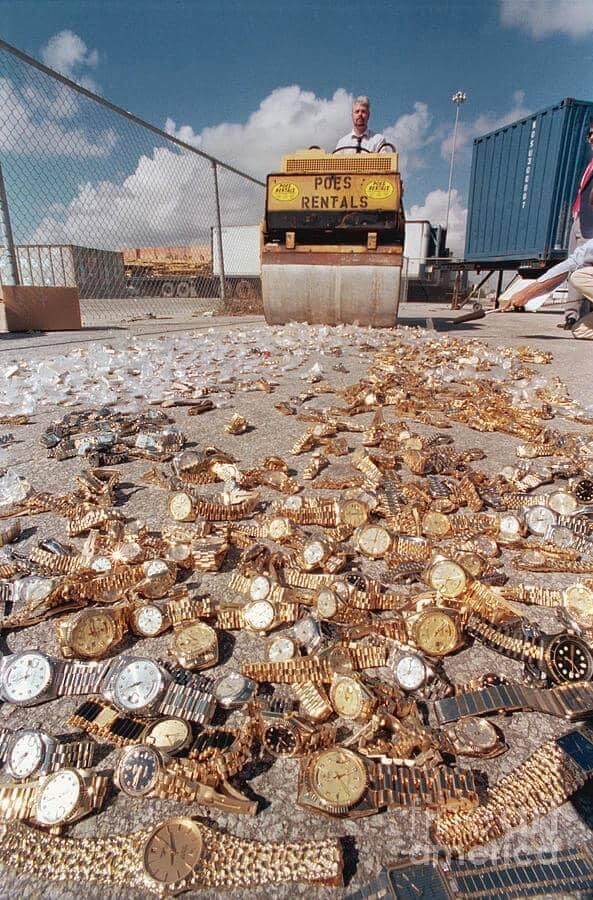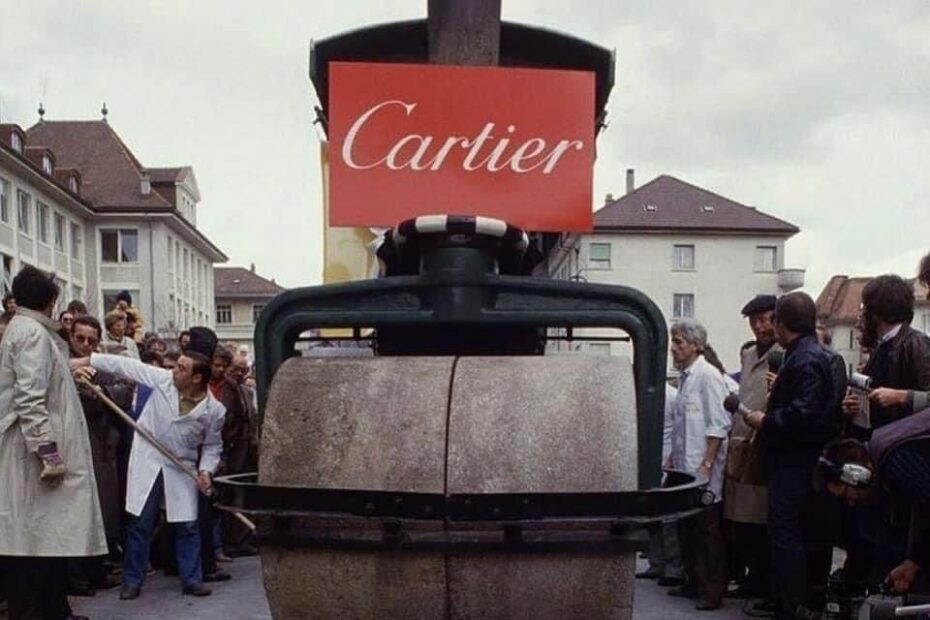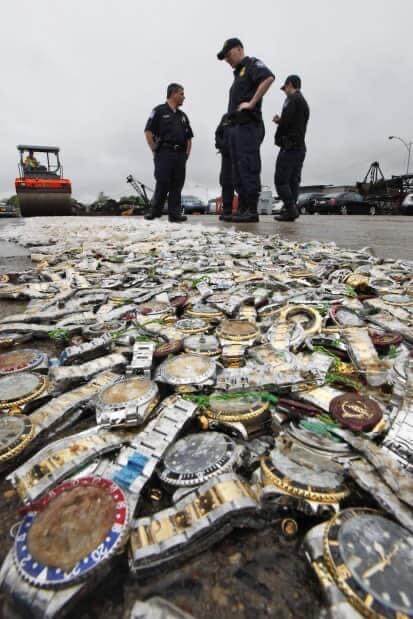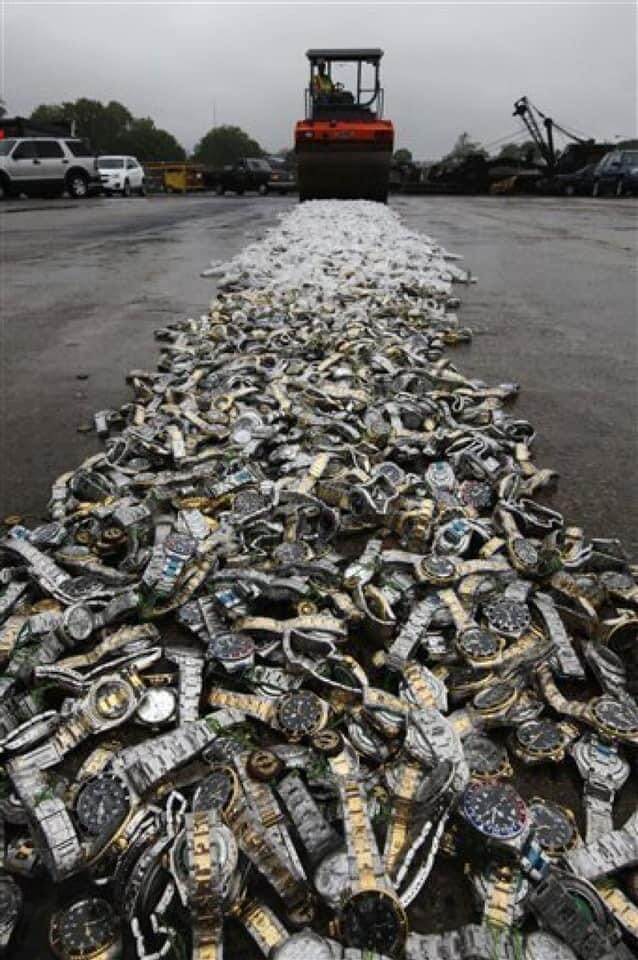The battle against counterfeit luxury goods, particularly watches, has escalated into a global spectacle. Cities worldwide, from New York to Paris, have taken a stand against this illegal trade. They’re not just seizing fake watches; they’re destroying them in public, sending a powerful message against the counterfeit industry.
In this detailed look, we delve into the crackdown on fake watches, with exclusive insights and images of these counterfeit goods meeting their dramatic end.
The Rising Tide of Counterfeits
The counterfeit watch market has surged, driven by the allure of luxury brands like Rolex and Cartier at a fraction of the price. However, the cost to brand reputation, the economy, and consumer trust is significant.
Counterfeits dilute brand value, support illicit activities, and often deceive consumers. Recognizing these threats, authorities worldwide have ramped up efforts to combat this issue.
New York’s Bold Measures
The crackdown on counterfeit watches in New York is strategic and symbolic. The city’s law enforcement agencies have conducted targeted raids, seizing thousands of counterfeit watches. These watches aren’t just confiscated; they’re publicly destroyed.
By crushing these fakes under rollers and bulldozers, New York sends a clear message: counterfeit goods have no place in the market.
This act of destruction serves as a deterrent and a public statement of the city’s commitment to protecting intellectual property rights.

France’s Elegant Enforcement
With Paris at its heart, France is synonymous with luxury and fashion. The French authorities have taken a sophisticated yet firm approach to counterfeit luxury goods. Like New York, France has staged public destruction of seized fake watches.
This approach eliminates counterfeit items from circulation and reinforces France’s global image as a protector of luxury brands and their legacy.
Global Efforts to Crush Counterfeits
The fight against counterfeit watches is a worldwide endeavor. From the bustling markets of Bangkok to the shopping centers of Dubai, authorities are seizing and destroying fake luxury watches.
These public destructions are part of a broader effort to uphold the integrity of the luxury goods market and protect consumers from fraud.
Countries increasingly collaborate and share intelligence and strategies to tackle this pervasive issue.
Witness the final moments of counterfeit luxury watches through our exclusive images. These powerful photos capture the destruction of fake Rolex and Cartier watches, once symbols of deceit, now reduced to metal and glass debris.
These images offer a rare glimpse into the fate of counterfeit goods. It highlights the resolve of global authorities to end the trade in fake luxury items.
In 2021 alone, global customs authorities seized over 23 million counterfeit goods, including luxury watches, according to the OECD. This staggering figure underscores the magnitude of the counterfeit watch industry and the ongoing efforts to combat it. Despite these challenges, coordinated actions between law enforcement agencies and luxury brands continue to make significant strides in disrupting counterfeit operations worldwide.
The Impact and the Future
The public destruction of counterfeit watches is more than a spectacle. It’s part of a comprehensive strategy to combat the counterfeit industry. This approach has multiple benefits:
- Deterrence: The visible destruction of counterfeit goods deters counterfeiters and consumers tempted by fake luxury items.
- Consumer Awareness: These events raise public awareness about the issue of counterfeits. It also educates consumers about the importance of purchasing authentic goods.
- Brand Protection: Authorities help preserve the value and integrity of genuine luxury brands by actively eliminating fake goods.
The fight against counterfeit watches will continue to evolve as we move forward. Technological advancements, including blockchain and AI, offer new tools to authenticate products and track their distribution.
However, the commitment of governments and brands to enforce intellectual property rights remains central to this effort.
Final Thoughts!
The global crackdown on fake watches symbolizes the collective resolve to protect consumers, brands, and the economy from counterfeiting harms. Through public destruction, authorities worldwide are making a statement against the counterfeit market.
These efforts, coupled with technological advancements, pave the way for a future where consumers can trust the authenticity of their luxury items. The message is clear: the era of counterfeit luxury is coming to an end.
As per a report by the OECD and the European Union Intellectual Property Office (EUIPO), counterfeit goods amounted to approximately $509 billion in 2016, accounting for 3.3% of global trade. However, this figure has shown signs of decline in recent years thanks to increased enforcement and awareness. For instance, between 2013 and 2016, the share of counterfeit and pirated goods in global trade fell from 2.5% to 2.25%. This decline reflects the impact of global efforts to combat counterfeiting and reinforces the notion that the fight against fake luxury items is making headway.








